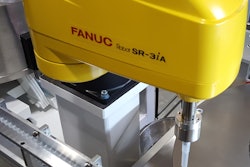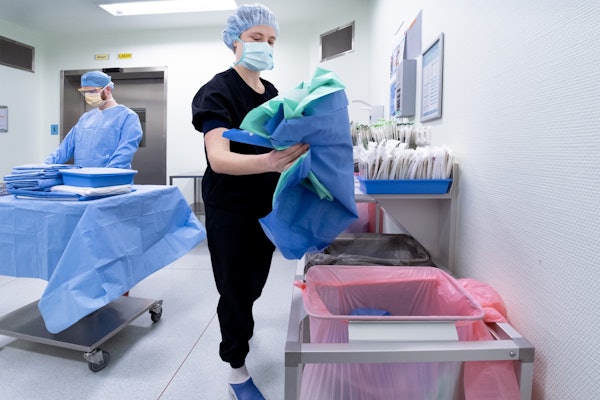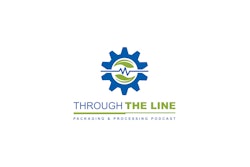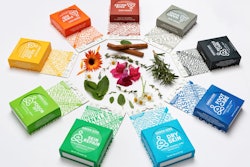What’s claimed to be the world’s first web-to-pack platform for folding cartons made an auspicious debut April 9 to 13 at an open house held at the Shenzhen, China facility of Xianjunlong Colour Printing Co. Ltd. A Primefire106 from Heidelberg starts by digitally printing the carton stock, which gets designed and ordered online. Once the B1 (40 in. wide) sheets have been printed, postpress operations are carried out digitally on a dmax 106 coating system from Steinemann configured with an in-line dfoil digital foiling module, also from Steinemann. Finally, a digital laser system from Heidelberg partner Masterwork Group Co., Ltd. takes care of carton creasing and cutting. Xianjunlong thus offers a completely digital production chain for folding cartons.
The platform—referred to as boxuni--connects packaging designers, print buyers, and producers with unparalleled efficiencies. It also combines Heidelberg’s well known software and technical capability with Xianjunlong’s strong footprint in the Chinese packaging industry.
One big benefit of this web-to-pack platform that converters of packaging materials will greatly appreciate is that it lets them fulfill prepress work online based on standards. Most prepress procedures—preflight, color management, trapping, imposition—can be done via this platform, and the print-ready PDFs will then be transferred directly to the converter’s digital devices for proofing or to CtP (Computer-to-Plate) devices for plate output. By putting prepress work on the platform, converters of packaging materials may no longer need to maintain their own prepress department, thus saving themselves a lot of time and cost.
Designers currently have online access to several hundred folding carton designs, with more being added all the time. This makes package design tailored to the designer’s specific requirements a quick, simple, and cost-effective process. As for packaging buyers, they can order packaging designs online – customized if necessary and also in the shortest of runs – which Xianjunlong then produces fully automatically and ships.
Heidelberg is also leading the way when it comes to creating a digital ecosystem for the packaging market in China’s print media industry. The next step is to give print shops the opportunity to link their products and services to this platform. For the first time, it will then be possible to use a cloud-based platform to produce folding cartons in a standardized, highly automated process with wide coverage in China.
“It’s the first time for Heidelberg that we’re working together with a customer to invest in a new business model, which will drive further growth in the packaging market,” says Ulrich Hermann, Management Board Member and Chief Digital Officer of Heidelberg. “We are intending to generate added value for the various industry stakeholders by creating a digital ecosystem. And by investing in a Heidelberg Primefire 106, Xianjunlong is underlining the importance of our industrial digital printing system for implementing new, data-driven business models.” According to Heidelberg, the Primefire at Xianjunlong is China’s first industrial digital printing system in the B1 format.
“We’re expecting the boxuni web-to-pack platform to revolutionize China’s packaging market,” says Xiao Ming Zhuang, Xianjunlong Colour Printing management team member. “In the future, designers, print buyers, and printers will all benefit from a highly automated, standardized process that will ultimately eliminate the need for correction cycles and coordination processes. We’ll use this digital business model to ensure the Primefire is used to its full capacity on a cost-effective basis.”
“China is the world’s largest market for folding carton production. It is worth over 30 billion euros and is growing at an annual rate of around 5 percent,” says Stephan Plenz, member of the Heidelberg Management Board responsible for Digital Technology. “China in particular is seeing a growing demand for short runs and even more customized packaging of very high quality, the perfect fit for the Heidelberg Primefire 106. We consider this the next step in a trend that will create further impetus for growth in the highly promising digital packaging printing segment,” he concludes.
Analysts and observers of the digital print for packaging space all agree that the Xianjunlong installation is impressive first and foremost because it represents a complete digital workflow for B1 sheets. “A number of others out there are trying to do just this, but Xianjunlong has actually pulled it off,” says Jordi Giralt, Sales Director of Primefire at Heidelberg. “It’s no wonder that more than 2,000 visitors came to see it during the three-day open house.”
Giralt also says it’s worth noting how profound an impact this installation could have simply because Xianjunlong is such a big player. “They have 50 offset presses, which makes them huge compared to nearly anything you’d see in the rest of the world,” says Giralt.
It’s also worth taking a look at the three main components this digital ecosystem consists of. The sheet-fed Primefire 106 accepts 40-in.-wide sheets and prints them at 2,500 sheets per hour. “Yes, we recognize that this is slow compared to our offset presses that run at 18,000 sheets per hour,” says Giralt. “But our primary consideration is print quality. Higher speeds will come later.” Giralt adds that the Primefire’s piezo-electric Samba print heads are from Fuji and the digital ink-jet inks are water-based, which makes them suitable for food applications.
Then there’s Steinemann’s dmax digital varnishing system. “Steinemann has installed so many units doing conventional coatings,” says Heidelberg's Giralt. “So when they decided to get into digital embellishment, they built upon a vast knowledge of the marketplace and the relevant technology because of their installed base.”
“It’s the fastest in the market,” says Steinemann’s Jurgen Stocker, Product Manager, in describing Steinemann’s digital embellishment technology. “It’s capable of 7,000 B1 format sheets per hour depending on the ink laydown and the paperboard grammage. Also, we are the only ones in the digital embellishing space whose system can do two applications, varnishing and foiling, in one pass. One Ricoh Generation 5 print head bar deposits the varnish and the other deposits a special glue that includes a thermoreactive element. Both varnish and glue are UV-cured by a system from IST. Then the sheet runs through the dfoil tower, where a hot rubber cylinder activates the UV-cured glue so it’s sticky again. Then the foil sticks only to where the glue was laid down.”
The thermoreactive glue, notes Jurgen, comes from Schmid-Rhyner, and the foil comes from Leonhard Kurz. Steinemann has established close and successful working relationships with Schmid-Rhyner and with Kurz over the years, and some attribute Steinemann’s success, in part at least, to this relationship.
Stocker also notes that thanks to 600 dpi resolution, Steinemann is the only one in the digital enhancement business that can reliably lay down a varnish ranging from 4 to 100 microns. Customers wanting just a visual pop may opt for a varnish laydown on the low end. But those seeking more than an embellishment that delivers tactilely as well as visually might go for a heavier varnish laydown.
As for Xianjunlong’s digital laser cutter from Masterwork Group (usually known as MK), it’s the first of its kind in the world. A notable differentiator compared to competitors in the market is in how the MK system produces the creasing lines. Like others, it uses a blanket or plate on which is digitally printed the pattern needed for the crease lines for the carton that is in production. But with MK the production of these crease lines is done offline. So you can be preparing the next job while you are producing another. With competitive systems this digital printing process is done on line, effectively taking the machine out of production for 15 minutes or so.
All in all, the web-to-pack project is a good example of how to deal with short print runs and more customized packaging with absolutely no reduction in quality.























